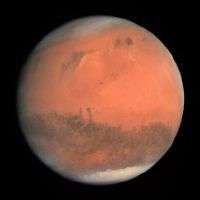Mars magnetic field mystery explained

(PhysOrg.com) -- So much attention has been paid to the similarities and differences between Earth and Mars that we often look to the ancient red planet for signposts in our own planet's future. A U of T physicist, whose work is published this week in the prestigious international journal Science, may have explained some key differences in the magnetic fields of the two planets.
On Mars, the magnetic fields frozen into surface rocks over four-billion-years-old provide a glimpse of an ancient era when the planet possessed a global magnetic field generated by motions in its fluid core.
"If Mars' past magnetic field generation process -- called a dynamo -- worked like Earth's does today, then we would expect similar magnetic field strengths in both the northern and southern hemispheres," said U of T Professor Sabine Stanley, lead author of the study.
"But Mars' crustal magnetic fields are strongest only in the southern hemisphere," she said.
This asymmetry in magnetic field strengths is correlated with another odd ancient crustal feature on Mars. The northern hemisphere crust is thinner and lower than the southern hemisphere crust. Possible explanations for this dichotomy include a giant low-angle impact in the northern hemisphere, or a large-scale hemispheric circulation pattern in Mars' mantle from which the crust formed. Both of these scenarios have implications for the temperature at the core-mantle boundary of Mars, making the northern boundary warmer than the southern boundary.
Stanley and colleagues from MIT and Brown University wondered if the crustal dichotomy formation process could also explain the hemispheric magnetic intensity differences.To investigate, they created a computer simulation for Mars' past dynamo that takes into account the hemispheric temperature differences imposed by Mars' mantle on the core. In the resulting simulation, strong magnetic fields were only generated in the southern hemisphere.
"It is encouraging when the solution to one problem also solves another problem," said Stanley. Previous hypotheses for the magnetic field asymmetry relied on processes that altered the northern hemisphere crust after Mars' dynamo died. "In our model, the proposed formation mechanism for the crustal dichotomy also explains the strange magnetic fields frozen into the rocks at that time."
The ancient magnetic field pattern also has implications for Mars' ancient atmosphere. It is difficult to explain the rapid loss of Mars' ancient atmosphere if the planet possessed a strong magnetic field at that time.
"Our model of Mars' past dynamo may help since the magnetic field would only be strong in the southern hemisphere. Atmospheric removal could still be efficient in the northern hemisphere," explained Stanley.
Provided by University of Toronto





















